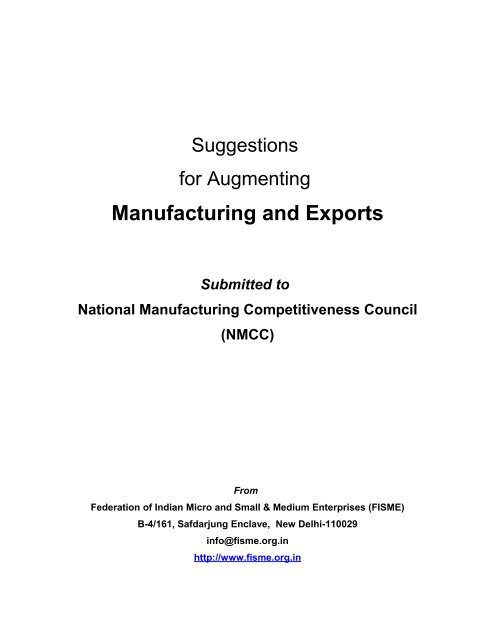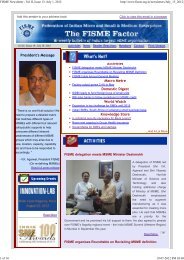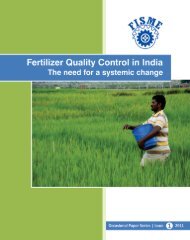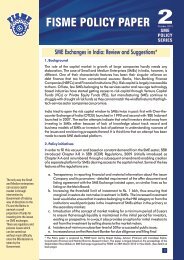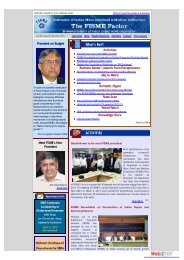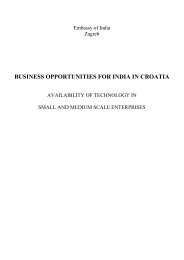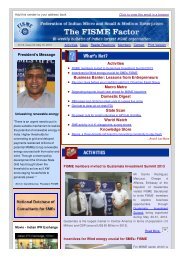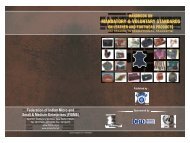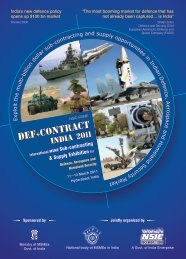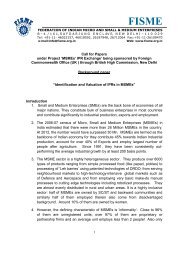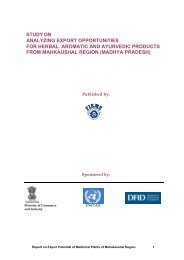NMCC - Federation of Indian Micro And Small and Medium ...
NMCC - Federation of Indian Micro And Small and Medium ...
NMCC - Federation of Indian Micro And Small and Medium ...
You also want an ePaper? Increase the reach of your titles
YUMPU automatically turns print PDFs into web optimized ePapers that Google loves.
Suggestions<br />
for Augmenting<br />
Manufacturing <strong>and</strong> Exports<br />
Submitted to<br />
National Manufacturing Competitiveness Council<br />
(<strong>NMCC</strong>)<br />
From<br />
<strong>Federation</strong> <strong>of</strong> <strong>Indian</strong> <strong>Micro</strong> <strong>and</strong> <strong>Small</strong> & <strong>Medium</strong> Enterprises (FISME)<br />
B-4/161, Safdarjung Enclave, New Delhi-110029<br />
info@fisme.org.in<br />
http://www.fisme.org.in
FISME’s Suggestions For<br />
Augmenting Manufacturing <strong>and</strong> Exports<br />
Background<br />
Manufacturing has been relatively a new phenomenon in independent India. The<br />
entrepreneurs entering into manufacturing peaked in 80s <strong>and</strong> the momentum<br />
continued till early 90s 1 . Several factors contributed to the boom in early 80s but<br />
two were most prominent: captive, growing <strong>Indian</strong> dem<strong>and</strong> <strong>and</strong> liberal funding<br />
(through State Financial corporations which may have paid a price for the<br />
liberalism, but they eventually created for India a large pool <strong>of</strong> small<br />
manufacturing enterprises).<br />
However, since late 90s, there has been a definite shift away from<br />
manufacturing. <strong>Indian</strong> markets opened up (Quantitative Restrictions abolished<br />
<strong>and</strong> Import duties came down drastically) <strong>and</strong> funding for enterprise creation<br />
dried up (most SFCs went belly-up <strong>and</strong> net bank credit to SSI sector came down<br />
from 15% in 1998 to hardly 6% in 2005-06). Changed economic dispensation<br />
coupled with stifled infrastructure led to large scale sickness. With no legal exit<br />
route in place, large number <strong>of</strong> entrepreneurs have had to face persecution, jail<br />
terms <strong>and</strong> relocation with enormous social cost.<br />
With new avenues opening up in services sector where it was possible to bypass<br />
infrastructural bottlenecks <strong>and</strong> regulatory rigidities, bulk <strong>of</strong> entrepreneurs<br />
considered manufacturing not worth the trouble. <strong>Indian</strong> economic grew without<br />
commensurate job growth. The sobering fact has been that growth <strong>of</strong> services<br />
create far less jobs <strong>and</strong> tend to include more elite work force leaving bulk <strong>of</strong> rural<br />
India.<br />
Current Context<br />
The period since 2003 has been <strong>of</strong> surging growth fuelled by internal<br />
consumption. ‘The setting has been provided by population demographics <strong>and</strong><br />
the trigger by low interest rates generated a boom through competitive retail<br />
finance market hitherto not witnessed in India chiefly in two segments: housing<br />
1<br />
See 3rd SSI Census (2001-02). Of total registered SSI units in 2001-02, around only 7% came up during<br />
1957-79; 5% during 80-84; 12.8% during 85-90; 27.8% during 91-96; 21% during 97-98; 19.6% during<br />
99-2000. Growth tapered thereafter.
<strong>and</strong> consumer durables. If you take the cement <strong>and</strong> primary iron products out,<br />
almost every single product <strong>and</strong> service used in the construction <strong>and</strong> finishing <strong>of</strong><br />
dwelling has a small sector stamp. Out <strong>of</strong> top 200 SSI products in terms <strong>of</strong> gross<br />
output (3 rd SSI Census), growth <strong>of</strong> 40 product categories are directly fuelled by<br />
housing alone such as paints, bricks/ tiles, building hardware, all form <strong>of</strong> wood<br />
articles, cement <strong>and</strong> concrete products, plastics, electrical products <strong>and</strong><br />
accessories, home furnishing etc. Then take services: plumbing, painting,<br />
electrical wiring, architectural services , interior decoration, steel fabrication,<br />
carpentry <strong>and</strong> so on. 2 ’<br />
The tide has turned in current fiscal year though. Rise in interest rates,<br />
appreciation <strong>of</strong> rupee <strong>and</strong> sobering <strong>of</strong> consumer dem<strong>and</strong> have the combined<br />
pairing impact on SME growth. Rise in interest rates have retarded the housing<br />
sector; rupee rise has blunted exports <strong>and</strong> high inflation has reduced consumer<br />
dem<strong>and</strong>. Though it will take at least 12-18 months for the combined impact <strong>of</strong><br />
these factors on industrial production to become fully apparent, some early<br />
disturbing signs are already on horizon. Industrial output is down to 9.7 percent<br />
between April <strong>and</strong> October compared with 10.1 percent in the same period.<br />
Though Exports during April-October rose by 20.9 per cent in dollar terms to<br />
$85.58 billion (Rs. 3,47,793.90 crore), export performance <strong>of</strong> most <strong>of</strong> SME<br />
intensive sectors show alarming signs <strong>of</strong> deceleration. During the period Textile<br />
exports fell by 22 per cent, h<strong>and</strong>icrafts by 66 per cent, leather by 9 per cent <strong>and</strong><br />
marine products almost by 20 per cent 3 .<br />
Augmenting manufacturing <strong>and</strong> exports growth<br />
1. Premise <strong>of</strong> FISME’s suggestions<br />
<br />
<br />
FISME has been <strong>of</strong> opinion that though the demographics <strong>and</strong> low interest rates<br />
created a boom in the short term- which was later killed prematurely by trying to<br />
reign in inflation by monetary measures alone, India still lacks the critical building<br />
blocks to sustain manufacturing <strong>and</strong> exports growth in long term amidst global<br />
competition.<br />
That the demographics will fuel growth is certain, what remains an open question<br />
is whether the domestic dem<strong>and</strong> would be satiated by <strong>Indian</strong> manufacturing thus<br />
2<br />
Plumbers, Carpenters <strong>and</strong> Growth’ by Anil Bhardwaj in <strong>Indian</strong> Express (11th April 1007 ) on how rise in<br />
interest rates would kill economic growth.<br />
3<br />
FISME’s Memor<strong>and</strong>um for Union Budget 2008-09
distributing the gains equitably <strong>and</strong> sustainably. To unleash <strong>Indian</strong><br />
entrepreneurship, on one h<strong>and</strong> we need to address the structural <strong>and</strong> institutional<br />
weaknesses in the system <strong>and</strong> on another we will have to equip <strong>and</strong> prod<br />
entrepreneurs for bracing global competition unabashedly.<br />
We believe that manufacturing capabilities <strong>and</strong> exportability are inter related <strong>and</strong><br />
mutually reinforcing. Sustainable competitiveness cannot be achieved only by<br />
provisioning <strong>of</strong> short term measures such as currency manipulation or hedging or<br />
SWAPs. In medium <strong>and</strong> long term, competitiveness could only be ensured by<br />
increasing productivity <strong>and</strong> reducing transaction costs in economy.<br />
2. Specific Suggestions for Manufacturing<br />
There are some key exogenous <strong>and</strong> endogenous factors that stifle manufacturing<br />
growth <strong>and</strong> limit exportability. Most <strong>of</strong> measures suggested by FISME aim at<br />
medium <strong>and</strong> short term gains.<br />
i. Improve access to competitively priced <strong>and</strong> adequate finance<br />
a. Restore interest rates to levels <strong>of</strong> 2005-06.<br />
b. Induce massive competition in Financial sector opening it up to foreign<br />
banks <strong>and</strong> lifting restrictions unilaterally<br />
c. Establish independent Regulatory Authority for Banks <strong>and</strong> FIs (on lines <strong>of</strong><br />
Telecom) to induce competition <strong>and</strong> improve service quality <strong>and</strong> let RBI<br />
concentrate management <strong>of</strong> larger macro-economic issues<br />
d. Regulate the Rating Companies for better service codes, their rating<br />
models <strong>and</strong> pricing. Do not let monopolies build in this domain.<br />
e. Do away with new barriers as third party rating under Basel-II ( see how<br />
EU has smartly classified its entire SME segment under retail)<br />
f. Remove policy impediments for new financial instruments such as<br />
‘Factoring’ to take <strong>of</strong>f<br />
g. Build new age institutional mechanisms for SMEs to raise equity (e.g.<br />
SME exchange on lines <strong>of</strong> South Africa, Brazil, China among others) <strong>and</strong><br />
facilitate Private Equity Funds in SME segment<br />
h. Restore Credit Linked Capital Subsidy Scheme (CLCSS) for<br />
Technological upgradation <strong>of</strong> SMEs
ii.<br />
Improve access to economically priced <strong>and</strong> adequate Electricity<br />
a. Support collective SME initiatives for distribution <strong>of</strong> electricity in<br />
geographical concentrations, industrial areas <strong>and</strong> clusters<br />
b. Remove policy impediments in open access particularly levy <strong>of</strong> subsidy<br />
element on collective initiatives<br />
c. Accord top priority on providing electricity to manufacturing units ( as has<br />
already been done in a few states)<br />
iii.<br />
Improve Industrial infrastructure<br />
a. Step-up building <strong>of</strong> hard infrastructure. Neither the current outlay <strong>and</strong> nor<br />
the institutional <strong>and</strong> operational mechanisms are commensurate to<br />
address huge existing gaps<br />
b. Urgently renew focus on creation <strong>of</strong> industrial areas with basic<br />
infrastructure – an area now languishing for over 15 years because <strong>of</strong><br />
lack <strong>of</strong> attention ( Creation <strong>of</strong> SEZs will not improve SMEs’ plight)<br />
c. Cede the administrative <strong>and</strong> tax collection powers to associations to<br />
maintain the Industrial Areas in PPP mode (there are already successful<br />
models in India)<br />
iv.<br />
Seamless movement <strong>of</strong> goods across states<br />
a. Establish unified Regulatory Agency to ensure seamless movement <strong>of</strong><br />
goods across states.<br />
b. Railways monopoly on freight movement needs to be broken. Un-bundle<br />
Railways (like Power sector) along operational lines into three separate<br />
independent operational companies: Railway stations, tracks <strong>and</strong><br />
services <strong>of</strong> carrying goods <strong>and</strong> passengers ( on lines <strong>of</strong> UK). Tracks <strong>and</strong><br />
stations should be available for universal use on fee basis. Let private<br />
companies start carrying the export cargo first.<br />
v. Education <strong>and</strong> Skilled workforce
[SMEs are suffering from acute skill shortages. Most ITIs have become<br />
redundant. The recent ITI upgradation programme is not SME need sensitive<br />
<strong>and</strong> is likely to have only marginal impact. ]<br />
a. Fund ‘district-wise skill deficiency mapping’ exercise <strong>and</strong> invite private<br />
parties to train people, develop skills, get them third party rated <strong>and</strong> pay<br />
fee based on success. ( there are already successful initiatives at a few<br />
places particularly in Gujarat)<br />
b. Fund Audio-visual <strong>and</strong> print aids for skill enhancement ( on lines <strong>of</strong> US)<br />
<strong>and</strong> also dedicate one DD channel for continuous skill development<br />
coupling it with distance education.<br />
c. Fund massive skill identification <strong>and</strong> grading programme for those not<br />
having any formal education but possessing requisite skills (on lines <strong>of</strong><br />
recent UNDP sponsored programme for leather craftsmen in Agra<br />
wherein 62,000 skilled craftsmen were identified <strong>and</strong> graded on skill level<br />
<strong>and</strong> ID cards issued to 47000 <strong>of</strong> them).<br />
vi.<br />
Labour Laws<br />
[Many states follow a flawed mechanism <strong>of</strong> determining Minimum Wages<br />
based on sectors in which a worker is employed. Therefore, a worker in<br />
Engineering sector is entitled to a different rate than the one in food<br />
processing sector. ]<br />
Nationally let there be a consensus on three issues:<br />
a. Base minimum wages on rational criteria <strong>and</strong> not sectorally or specific to<br />
industry ( unlike the current situation in many states where a worker in<br />
Engineering sector is entitled to a different rate than the one in food<br />
processing sector)<br />
b. Allow Contract labour ( as already in many states)<br />
c. Provide an option to SMEs for using market based mechanism for ESI<br />
<strong>and</strong> PF <strong>and</strong> after having contributed let them be freed from keeping<br />
records <strong>and</strong> unnecessary formalities. (ESI in particular is one <strong>of</strong> the most<br />
useless scheme where huge contribution goes waste in dilapidated ESI<br />
infrastructure that nobody uses.)
vii.<br />
Taxes<br />
[Area based exemptions create huge disparities with in India. The current<br />
dispensation rewards inefficient companies <strong>and</strong> punish efficient ones. SMEs<br />
suffer most in such conditions.]<br />
a. Suspend area based exemptions ( e,g. in Himachal <strong>and</strong> Uttrakh<strong>and</strong>)<br />
forthwith<br />
b. Stay on course for GST by 2010<br />
c. Remove tax barriers like Entry Tax <strong>and</strong> Octroi which are the biggest<br />
barriers in making India one market<br />
viii.<br />
Bankruptcy <strong>and</strong> Insolvency Codes<br />
a. Put in place the modern bankruptcy <strong>and</strong> insolvency codes reflecting the<br />
needs <strong>of</strong> ruthless competitive markets <strong>and</strong> uncertainties in globalization<br />
so that while entrepreneurs are encouraged to take risk, lenders are<br />
confident <strong>of</strong> quick disposal <strong>of</strong> cases <strong>and</strong> repossession <strong>of</strong> assets after<br />
failure. (Remember what Thomas Freidman states in Lexus <strong>and</strong> Live<br />
Tree on critical policy the countries would need in globalization, “…the<br />
bankruptcy laws <strong>and</strong> courts that actually encourage people who fail in<br />
business venture to declare bankruptcy <strong>and</strong> try again, perhaps fail again ,<br />
declare bankruptcy <strong>and</strong> then try again before succeeding <strong>and</strong> creating<br />
the next amazon.com’)<br />
ix.<br />
Benchmarking <strong>of</strong> best manufacturing practices<br />
a. Fund benchmarking <strong>of</strong> best manufacturing practices (within India) in top<br />
20 SME segments having dominance in exports (a cue could be taken<br />
from recent World Bank study 4 on Competitiveness in India)<br />
x. Stamp Duties<br />
[High stamp duties on transfer <strong>of</strong> property <strong>and</strong> on commercial transactions<br />
such as on financial instruments create huge cascading effect. ]<br />
a. Harmonize the Stamp Duties across states <strong>and</strong> drastically reduce them<br />
4<br />
‘Unleashing India’s Innovation: Toward Sustainable <strong>and</strong> Inclusive Growth’ Mark A. Dutz, Editor<br />
World Bank 2007
xi.<br />
Productivity: Cutting waste<br />
a. Having identified gaps in processes through benchmarking studies,<br />
provide financial support to SMEs to encourage use <strong>of</strong> expert services to<br />
cut waste<br />
b. Fund technological upgradation in plants & machinery suppliers for top 20<br />
SME dominated export impacting embedded services<br />
xii.<br />
Informal to formal<br />
a. Fund comprehensive study to map reasons for informality in India to<br />
identify areas <strong>of</strong> reforms in regulatory <strong>and</strong> taxation regime<br />
b. Special fiscal <strong>and</strong> tax incentives to encourage vertical growth <strong>and</strong><br />
building <strong>of</strong> scale<br />
xiii.<br />
SME Audit <strong>of</strong> Laws<br />
a. Constitute a mechanism whereby all laws <strong>and</strong> bills go through m<strong>and</strong>atory<br />
‘SME Audit’ ( on lines <strong>of</strong> US <strong>and</strong> EU) pre-empting negative fall out <strong>of</strong><br />
existing <strong>and</strong> emerging regulations<br />
3. Suggestions for Exports<br />
i. Comprehensive Programme for Internationalization <strong>of</strong> SMEs<br />
a. Fund a comprehensive long term SME export support programme to<br />
increase SME participation in exports from current levels <strong>of</strong> 0.5% <strong>of</strong><br />
registered SMEs to 5% in next 10 years leveraging export promotion<br />
schemes <strong>of</strong> center <strong>and</strong> states with cluster development programmes.<br />
[FISME is ready to provide a detailed blue print for this ambitious initiative<br />
based on global best practices]<br />
ii.<br />
<strong>Indian</strong> Missions: Hub <strong>of</strong> Commercial Services<br />
a. Let <strong>Indian</strong> Missions adopt the Commercial Service Model (<strong>of</strong> US<br />
Department <strong>of</strong> Commerce delivered through US Embassies; <strong>of</strong> UK <strong>and</strong><br />
Australia.) to provide value added services to exporters<br />
b. Put in place a mechanism for regular briefing <strong>of</strong> our senior mission<br />
<strong>of</strong>ficials by Industry Associations
c. Facilitate ‘Export Incubation’ – boucket <strong>of</strong> support services through<br />
Embassies so that exporting companies could establish their presence in<br />
major markets<br />
iii.<br />
Bad debt recovery/ payment defaults<br />
a. Break the monopoly <strong>of</strong> Export Credit Guarantee Corporation (ECGC)<br />
services <strong>of</strong> which most SMEs find loathsome <strong>and</strong> hugely inefficient.<br />
Allowing large banks, insurance <strong>and</strong> private companies to develop<br />
innovative instruments to hedge payment defaults for SMEs<br />
b. Fund/ facilitate development a mechanism through which SMEs could<br />
take services <strong>of</strong> recovery agents in importing countries in case <strong>of</strong><br />
defaults.<br />
iv.<br />
Provide Representation to SME bodies<br />
a. Provide due representation to SMEs in Prime Minister’s Economic<br />
Council, Board <strong>of</strong> Trade <strong>and</strong> other Trade related decision making bodies<br />
in Ministry <strong>of</strong> Commerce for better appreciation <strong>of</strong> their needs in policy<br />
decisions (none <strong>of</strong> SME bodies are represented in these committees).


